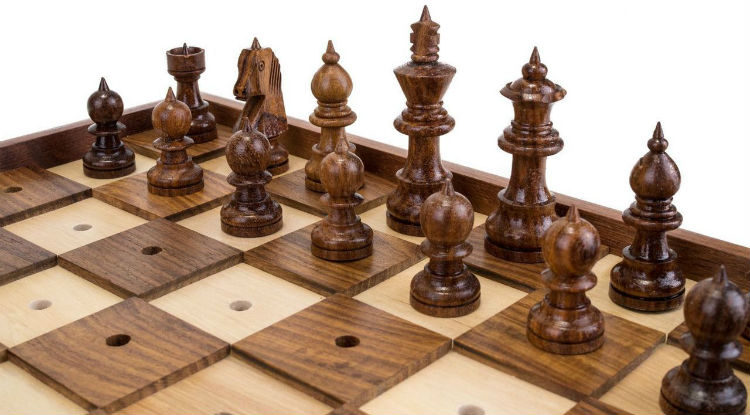I believe that chess offers leverage for all people. Kaptain
Chess and the Blind
How Visually Impaired Play Chess
The Chess Board of 64 squares has the following modifications:
- All the Black squares are raised about 3-4 mm above the white squares. By feeling the squares, the player is able to determine whether the square is a black or a white one.
- Each of the squares on the Board has a hole in the centre so that the pieces can be fixed in these holes.
- Each of the pieces has a downward projection (nail) at the base, which fits into the hole in the squares on the Board, thereby fixing the piece securely on the board.
- All the Black pieces have a pin fixed on their heads helping the player distinguish between a white and a black piece.
The players therefore, by feeling the raised or the lowered squares can figure out whether the piece is on a black or a white square. By feeling the shape of the piece, they can determine whether the piece is a Pawn, Rook, Bishop, Knight, Queen or King. The touch of the pin on the pieces helps the player from distinguishing a white piece from a black one. The player is therefore able to have a clear picture in his mind of the position on the Board. He is now ready to take on any opponent, sighted or otherwise.
After making every move, the visually impaired person is required to announce the move aloud, so that his opponent comes to know of the move. Instead of writing the moves on a Score Sheet, the visually impaired player writes the moves in Braille or records the moves on a tape recorder. …. provided by the IBCA

Chess and Disabilities
Chess and Autism
Autism I have had the pleasure to have had 6 ADM in my class none was pointed out before class began.
The Autism-Genius Connection
Chess champion Magmus Carlsen illustrates social costs of unusual creativity.
Posted May 11, 2017
Some people are exceptionally good at focusing on rarefied abstract problems. Some of these have exceptionally high IQ. Some are autistic. Some are both.
This link was raised in a recent movie (Magnus) chronicling the life of world chess champion Magnus Carlsen, who emphatically denies that he is autistic. This denial is treated skeptically in the movie, however.
Tuning in to a Talent, versus Tuning out Other People
One of the key paradoxes in the lives of highly creative people is that high achievement is promoted by an exclusive focus on some one field of endeavor. Whether it is Edison inventing the electric light bulb, or Beethoven writing a symphony, the capacity to transcend prodigious challenges requires a keen ability to screen out distractions, whether social, or practical. Highly creative people are not inherently asocial, of course, and neither are autistic individuals, whatever problems they might have in negotiating the social landscape.
Even so, tuning in on a talent often requires tuning out other people. In the documentary movie, Magnus, the protagonist spends much of his time absorbed in the world of electronic chess where family members get tuned out. This illustrates the social costs of unusual creativity in any field.
Chess is a social game, of course, and it involves a fair amount of gamesmanship like showing up at the last minute to unsettle an opponent. As in boxing, the confidence game—getting inside an opponent’s head—is often as important as the player’s actual moves.
Chess experts distinguish opening moves that can be memorized to some extent from the middle game that is a great deal more fluid, or improvisational. Carlsen uses a great variety of opening moves, making it difficult for opponents to prepare. He excels in the middle game and overwhelms opponents with creative moves and counter moves. At that point, it is as though an inexperienced sword fighter finds themselves in a duel to the death with a tireless opponent who has buried all previous challengers.
Autistic Savants
Autistic savants are people who suffer from a developmental disability yet demonstrate some cognitive ability, exceeding what most people can do (1). These abilities may involve, art, music, arithmetic, spatial skills, or calendar abilities—where the savant can determine what day of the week some date is with speed and accuracy. About half of savants are autistic, the others suffering from some form of brain injury or disease. About a tenth of autistic people have savant abilities.
Another common skill manifested by savants is prodigious feats of memory. As a small child, Carlsen amused himself by memorizing the capital cities, and flags, of all the countries of the world. Such narrow and intense focus is characteristic of autism, as is his ongoing preoccupation with Donald Duck movies.
Individuals with autism spectrum condition often exhibit unusual skills in attention and perception relative to the general public (2). This might be helpful in memorizing chess moves. In fact, this capacity—that is uniquely developed in autistic individuals—may be a key to developing unusual talents.
Autism and Talent
Exceptional talent in autistic individuals may begin with sensory hypersensitivity that makes many uncomfortable in proximity to loud noises, for example (2). They have great attention to detail and organize the perceptual world to an unusual degree—a phenomenon referred to as hyper-systematizing.
This propensity even affects observable behavior where daily routines are repeated in exactly the same way. Even small children express a craving for organization by arranging their toys in neat lines.
Hyper-systematizing propensities may be expressed in savant-like activities, such as calendar abilities that are not very socially useful, or they may contribute to socially-celebrated achievements in the visual arts, or chess. Whether Carlsen is on the autistic spectrum or not, his exceptional chess skills at least bear analogy with the accomplishments of autistic savants.
Adaptive Significance
At present, the brain basis of autism is poorly understood and the same is even more true of savant abilities. One of the great mysteries of brain development is the way that even as some capacities are sharpened—as a youngster acquires efficient contact with the social and non social environment—others are tuned down.
This phenomenon is illustrated by savant abilities of attention, and memory and the autistic trait of hyper-systematization, that are far less developed in people outside the autistic spectrum. This speaks to compromises and limitations in brain development and function.
The same general principle applies to adult brain function. For example, the decay of some old memories may improve brain function by getting rid of clutter. Similarly, inattention to details that are perceived as trivial may be an inevitable side effect of having a brain that sorts events according to their emotional significance so that beautiful strangers walking down the street are more likely to register than their less attractive counterparts.
The great range of human cognitive capacities suggests that there is no single optimum when it comes to brain development, or function. Some people function well despite having limited capacity for memorization whereas others have almost unlimited recall. Some are exceptionally good at attending to details whereas others quickly get bored.
Given that boredom is a leading problem in the workforce, employers are discovering that autistic people make ideal employees in some jobs, including human resources, benefits administration, and coding where attention to detail is very important. This is an everyday example of the specialized autistic abilities that contribute to more glamorous achievements in art, chess, and music.
